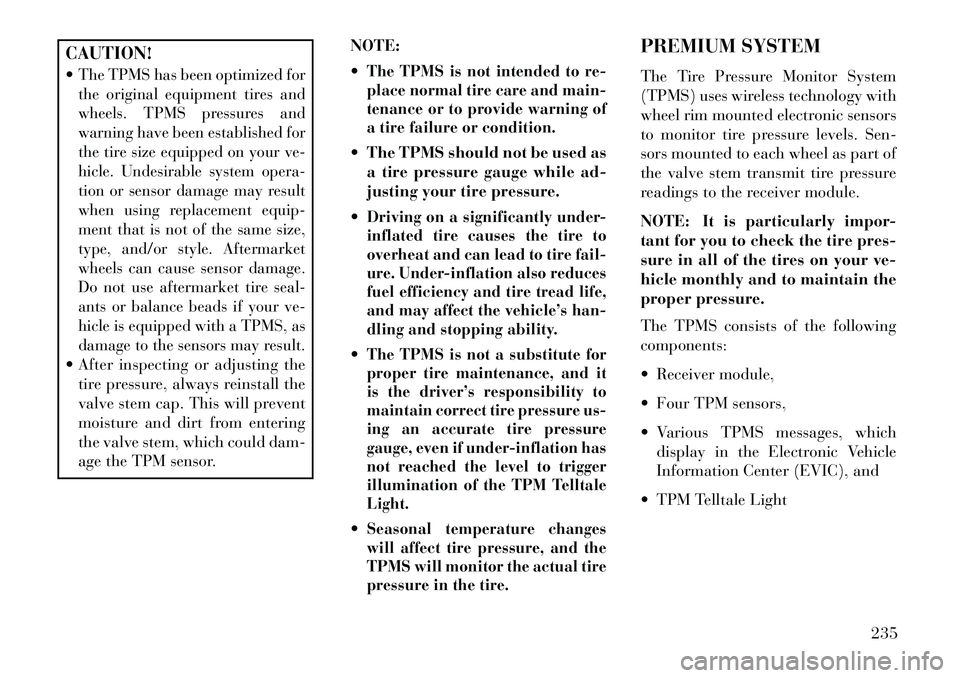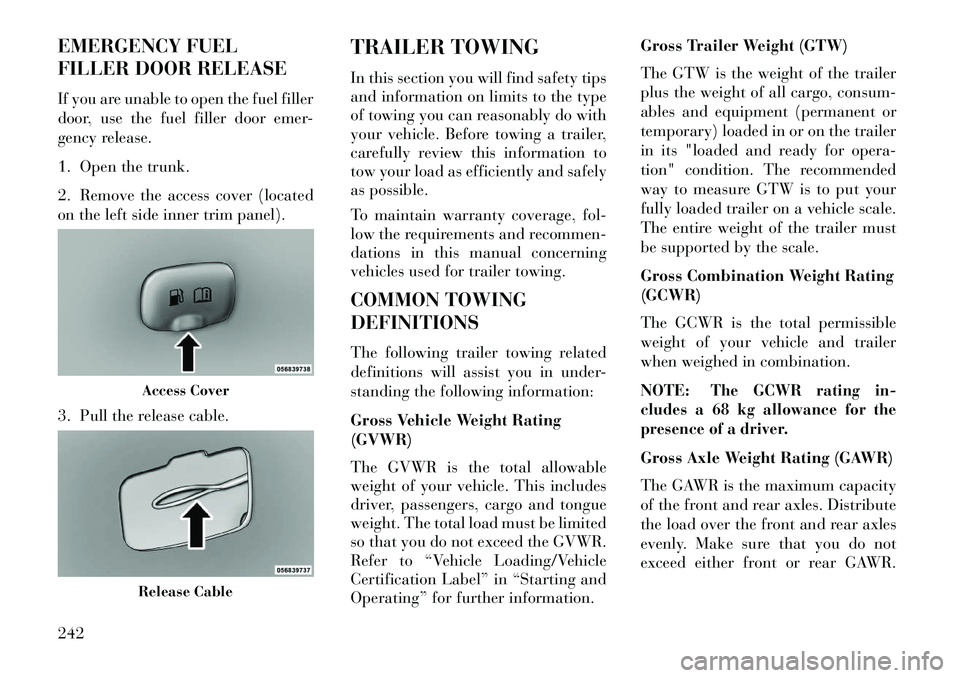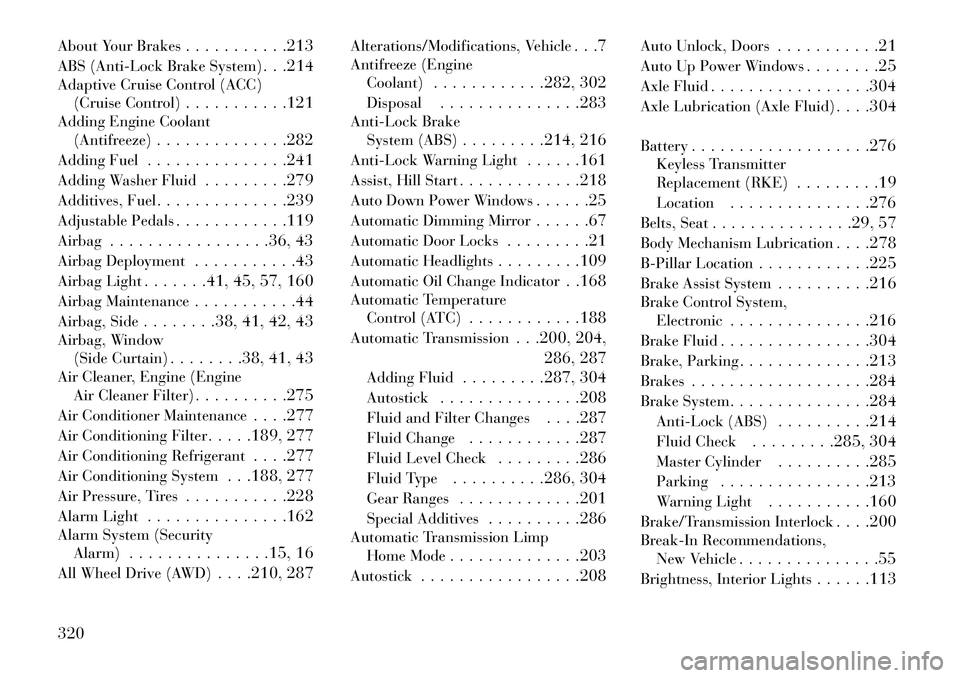tire type Lancia Thema 2013 Owner handbook (in English)
[x] Cancel search | Manufacturer: LANCIA, Model Year: 2013, Model line: Thema, Model: Lancia Thema 2013Pages: 336, PDF Size: 3.87 MB
Page 241 of 336

CAUTION!
The TPMS has been optimized for
the original equipment tires and
wheels. TPMS pressures and
warning have been established for
the tire size equipped on your ve-
hicle. Undesirable system opera-
tion or sensor damage may result
when using replacement equip-
ment that is not of the same size,
type, and/or style. Aftermarket
wheels can cause sensor damage.
Do not use aftermarket tire seal-
ants or balance beads if your ve-
hicle is equipped with a TPMS, as
damage to the sensors may result. After inspecting or adjusting thetire pressure, always reinstall the
valve stem cap. This will prevent
moisture and dirt from entering
the valve stem, which could dam-
age the TPM sensor. NOTE:
The TPMS is not intended to re-
place normal tire care and main-
tenance or to provide warning of
a tire failure or condition. The TPMS should not be used as
a tire pressure gauge while ad-
justing your tire pressure.
Driving on a significantly under-
inflated tire causes the tire to
overheat and can lead to tire fail-
ure. Under-inflation also reduces
fuel efficiency and tire tread life,
and may affect the vehicle’s han-
dling and stopping ability.The TPMS is not a substitute for
proper tire maintenance, and it
is the driver’s responsibility to
maintain correct tire pressure us-
ing an accurate tire pressure
gauge, even if under-inflation has
not reached the level to trigger
illumination of the TPM Telltale
Light.Seasonal temperature changes
will affect tire pressure, and the
TPMS will monitor the actual tire
pressure in the tire.
PREMIUM SYSTEM
The Tire Pressure Monitor System
(TPMS) uses wireless technology with
wheel rim mounted electronic sensors
to monitor tire pressure levels. Sen-
sors mounted to each wheel as part of
the valve stem transmit tire pressure
readings to the receiver module.
NOTE: It is particularly impor-
tant for you to check the tire pres-
sure in all of the tires on your ve-
hicle monthly and to maintain the
proper pressure.
The TPMS consists of the following
components:
Receiver module,
Four TPM sensors,
Various TPMS messages, which display in the Electronic Vehicle
Information Center (EVIC), and
TPM Telltale Light
235
Page 248 of 336

EMERGENCY FUEL
FILLER DOOR RELEASE
If you are unable to open the fuel filler
door, use the fuel filler door emer-
gency release.
1. Open the trunk.
2. Remove the access cover (located
on the left side inner trim panel).
3. Pull the release cable.TRAILER TOWING
In this section you will find safety tips
and information on limits to the type
of towing you can reasonably do with
your vehicle. Before towing a trailer,
carefully review this information to
tow your load as efficiently and safely
as possible.
To maintain warranty coverage, fol-
low the requirements and recommen-
dations in this manual concerning
vehicles used for trailer towing.
COMMON TOWING
DEFINITIONS
The following trailer towing related
definitions will assist you in under-
standing the following information:
Gross Vehicle Weight Rating
(GVWR)
The GVWR is the total allowable
weight of your vehicle. This includes
driver, passengers, cargo and tongue
weight. The total load must be limited
so that you do not exceed the GVWR.
Refer to “Vehicle Loading/Vehicle
Certification Label” in “Starting and
Operating” for further information.Gross Trailer Weight (GTW)
The GTW is the weight of the trailer
plus the weight of all cargo, consum-
ables and equipment (permanent or
temporary) loaded in or on the trailer
in its "loaded and ready for opera-
tion" condition. The recommended
way to measure GTW is to put your
fully loaded trailer on a vehicle scale.
The entire weight of the trailer must
be supported by the scale.
Gross Combination Weight Rating
(GCWR)
The GCWR is the total permissible
weight of your vehicle and trailer
when weighed in combination.
NOTE:
The GCWR rating in-
cludes a 68 kg allowance for the
presence of a driver.
Gross Axle Weight Rating (GAWR)
The GAWR is the maximum capacity
of the front and rear axles. Distribute
the load over the front and rear axles
evenly. Make sure that you do not
exceed either front or rear GAWR.
Access CoverRelease Cable
242
Page 251 of 336

TRAILER TOWING WEIGHTS (MAXIMUM TRAILER WEIGHT RATINGS)
The following chart provides the maximum trailer weight ratings towable for your given drivetrain.
Engine/TransmissionFrontal AreaMax. GTW
(Gross Trailer Wt.) Max. Tongue Wt.
(See Note)
3.6L Automatic 2.04 sq m 1 725 kg86 kg
3.0L Diesel Automatic 2.97 sq m 1 996 kg100 kg
Refer to local laws for maximum trailer towing speeds
NOTE: The trailer tongue weight must be considered as part of the combined weight of occupants and cargo,
and it should never exceed the weight referenced on the “Tire and Loading Information” placard. Refer to
“Tire Safety Information” in “Starting and Operating” for further information.
TRAILER AND TONGUE
WEIGHT
Always load a trailer with 60% to
65% of the weight in the front of the
trailer. This places 5% of the Gross
Trailer Weight (GTW) on the tow
hitch of your vehicle. Loads balanced
over the wheels or heavier in the rear
can cause the trailer to sway severely
side to side which will cause loss of
control of the vehicle and trailer. Fail-
ure to load trailers heavier in front is
the cause of many trailer collisions.
Never exceed the maximum tongue
weight stamped on your bumper or
trailer hitch. Consider the following items when
computing the weight on the rear axle
of the vehicle:
The tongue weight of the trailer.
The weight of any other type of
cargo or equipment put in or on
your vehicle. The weight of the driver and all
passengers.
NOTE: Remember that every-
thing put into or on the trailer adds
to the load on your vehicle. Also,
additional factory-installed op-
tions or dealer-installed options
must be considered as part of the
total load on your vehicle. Refer to
the “Tire and Loading Informa-
tion” placard for the maximum
combined weight of occupants and
cargo for your vehicle.
245
Page 326 of 336

About Your Brakes. . . . . . . . . . .213
ABS (Anti-Lock Brake System) . . .214
Adaptive Cruise Control (ACC) (Cruise Control) . . . . . . . . . . .121
Adding Engine Coolant (Antifreeze) . . . . . . . . . . . . . .282
Adding Fuel . . . . . . . . . . . . . . .241
Adding Washer Fluid . . . . . . . . .279
Additives, Fuel . . . . . . . . . . . . . .239
Adjustable Pedals . . . . . . . . . . . .119
Airbag . . . . . . . . . . . . . . . . .36, 43
Airbag Deployment . . . . . . . . . . .43
Airbag Light . . . . . . .41, 45, 57, 160
Airbag Maintenance . . . . . . . . . . .44
Airbag, Side . . . . . . . .38, 41, 42, 43
Airbag, Window (Side Curtain) . . . . . . . .38, 41, 43
Air Cleaner, Engine (Engine Air Cleaner Filter) . . . . . . . . . .275
Air Conditioner Maintenance . . . .277
Air Conditioning Filter . . . . .189, 277
Air Conditioning Refrigerant . . . .277
Air Conditioning System . . .188, 277
Air Pressure, Tires . . . . . . . . . . .228
Alarm Light . . . . . . . . . . . . . . .162
Alarm System (Security Alarm) . . . . . . . . . . . . . . .15, 16
All Wheel Drive (AWD) . . . .210, 287Alterations/Modifications, Vehicle
. . .7
Antifreeze (Engine Coolant) . . . . . . . . . . . .282, 302
Disposal . . . . . . . . . . . . . . .283
Anti-Lock Brake System (ABS) . . . . . . . . .214, 216
Anti-Lock Warning Light . . . . . .161
Assist, Hill Start . . . . . . . . . . . . .218
Auto Down Power Windows . . . . . .25
Automatic Dimming Mirror . . . . . .67
Automatic Door Locks . . . . . . . . .21
Automatic Headlights . . . . . . . . .109
Automatic Oil Change Indicator . .168
Automatic Temperature Control (ATC) . . . . . . . . . . . .188
Automatic Transmission . . .200, 204,
286, 287
Adding Fluid . . . . . . . . .287, 304
Autostick . . . . . . . . . . . . . . .208
Fluid and Filter Changes . . . .287
Fluid Change . . . . . . . . . . . .287
Fluid Level Check . . . . . . . . .286
Fluid Type . . . . . . . . . .286, 304
Gear Ranges . . . . . . . . . . . . .201
Special Additives . . . . . . . . . .286
Automatic Transmission Limp Home Mode . . . . . . . . . . . . . .203
Autostick . . . . . . . . . . . . . . . . .208 Auto Unlock, Doors
. . . . . . . . . . .21
Auto Up Power Windows . . . . . . . .25
Axle Fluid . . . . . . . . . . . . . . . . .304
Axle Lubrication (Axle Fluid) . . . .304
Battery . . . . . . . . . . . . . . . . . . .276
Keyless Transmitter
Replacement (RKE) . . . . . . . . .19
Location . . . . . . . . . . . . . . .276
Belts, Seat . . . . . . . . . . . . . . .29, 57
Body Mechanism Lubrication . . . .278
B-Pillar Location . . . . . . . . . . . .225
Brake Assist System . . . . . . . . . .216
Brake Control System, Electronic . . . . . . . . . . . . . . .216
Brake Fluid . . . . . . . . . . . . . . . .304
Brake, Parking . . . . . . . . . . . . . .213
Brakes . . . . . . . . . . . . . . . . . . .284
Brake System . . . . . . . . . . . . . . .284
Anti-Lock (ABS) . . . . . . . . . .214
Fluid Check . . . . . . . . .285, 304
Master Cylinder . . . . . . . . . .285
Parking . . . . . . . . . . . . . . . .213
Warning Light . . . . . . . . . . .160
Brake/Transmission Interlock . . . .200
Break-In Recommendations, New Vehicle . . . . . . . . . . . . . . .55
Brightness, Interior Lights . . . . . .113
320